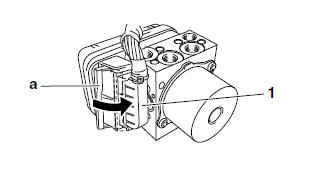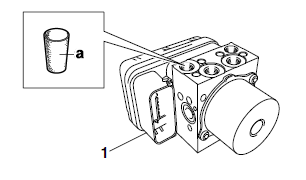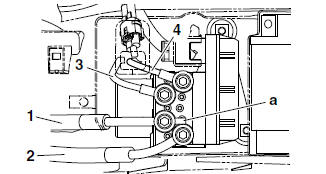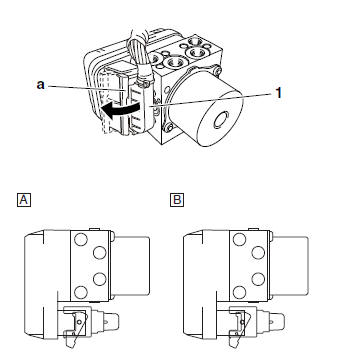 Yamaha Tracer MT09TRA - Service manual > Removing the hydraulic unit assembly
Yamaha Tracer MT09TRA - Service manual > Removing the hydraulic unit assembly
NOTICE
Unless necessary, avoid removing and installing the brake hoses of the hydraulic unit assembly.
WARNING
Refill with the same type of brake fluid that is already in the system. Mixing fluids may result in a harmful chemical reaction, leading to poor braking performance.
NOTICE
- Handle the ABS components with care since they have been accurately
adjusted.
Keep them away from dirt and do not subject them to shocks.
- Do not turn the main switch to "ON" when removing the hydraulic unit assembly.
- Do not clean with compressed air.
- Do not reuse the brake fluid.
- Brake fluid may damage painted surfaces and plastic parts. Therefore, always clean up any spilt brake fluid immediately.
- Do not allow any brake fluid to contact the couplers. Brake fluid may damage the couplers and cause bad contacts.
- If the union bolts for the hydraulic unit assembly have been removed, be sure to tighten them to the specified torque and bleed the brake system.
1. Disconnect:
- ABS ECU coupler "1"
TIP
Pull the lock lever "a" of the ABS ECU coupler in the direction of the arrow shown, and then disconnect the coupler.

2. Remove:
- Brake hoses
TIP
Do not operate the brake lever and brake pedal while removing the brake hoses.
NOTICE
When removing the brake hoses, cover the area around the hydraulic unit assembly to catch any spilt brake fluid. Do not allow the brake fluid to contact other parts.
3. Remove:
- Hydraulic unit assembly "1"
TIP
- To avoid brake fluid leakage and to prevent foreign materials from entering the hydraulic unit assembly, insert a rubber plug "a" or a bolt (M10 x 1.0) into each brake hose union bolt hole.
- When using a bolt, do not tighten the bolt until the bolt head touches the hydraulic unit. Otherwise, the brake hose union bolt seating surface could be deformed.

Checking the hydraulic unit assembly
1. Check:
- Hydraulic unit assembly
Cracks/damage → Replace the hydraulic unit assembly and the brake pipes that are connected to the assembly as a set.
Installing the hydraulic unit assembly
1. Install:
- Hydraulic unit assembly
NOTICE
Do not remove the rubber plugs or bolts (M10 x 1.0) installed in the brake hose union bolt holes before installing the hydraulic unit assembly.
TIP
Do not allow any foreign materials to enter the hydraulic unit assembly or the brake hoses when installing the hydraulic unit assembly.
2. Remove:
- Rubber plugs or bolts (M10 x 1.0)
3. Install:
- Front brake hose (front brake master cylinder to hydraulic unit) "1"
- Front brake hose (hydraulic unit to front brake caliper) "2"
- Rear brake hose (rear brake master cylinder to hydraulic unit) "3"
- Rear brake hose (hydraulic unit to rear brake caliper) "4"
- Gaskets

- Brake hose union bolts
 Front brake hose union
bolt 30 Nm (3.0 m*kgf, 22 ft*lbf)
Front brake hose union
bolt 30 Nm (3.0 m*kgf, 22 ft*lbf)
Rear brake hose union bolt 30 Nm (3.0 m*kgf, 22 ft*lbf)
NOTICE
If the brake hose union bolt does not turn easily, replace the hydraulic unit assembly, brake hoses, and related parts as a set.
TIP
When installing the brake hose (front brake master cylinder to hydraulic unit), make sure that the stopper "a" on the hose contacts the brake hose (hydraulic unit to front brake caliper).

4. Connect:
- ABS ECU coupler "1"
TIP
- Connect the ABS ECU coupler, and then push the lock lever "a" of the coupler in the direction of the arrow shown.
- Make sure that the ABS ECU coupler is connected in the correct position as shown in illustration "A".

A. The ABS ECU coupler is connected correctly.
B. The ABS ECU coupler is not connected.
5. Fill:
- Brake master cylinder reservoir
- Brake fluid reservoir (with the specified amount of the specified brake fluid)
 Specified brake fluid
DOT 4
Specified brake fluid
DOT 4
WARNING
- Use only the designated brake fluid. Other brake fluids may cause the rubber seals to deteriorate, causing leakage and poor brake performance.
- Refill with the same type of brake fluid that is already in the system. Mixing brake fluids may result in a harmful chemical reaction, leading to poor brake performance.
- When refilling, be careful that water does not enter the brake fluid reservoir. Water will significantly lower the boiling point of the brake fluid and could cause vapor lock.
NOTICE
Brake fluid may damage painted surfaces and plastic parts. Therefore, always clean up any spilt brake fluid immediately.
6. Bleed:
- Brake system Refer to "BLEEDING THE HYDRAULIC BRAKE SYSTEM (ABS)"
7. Check the operation of the hydraulic unit according to the brake lever and the brake pedal response.
NOTICE
Always check the operation of the hydraulic unit according to the brake lever and the brake pedal response.
8. Delete the fault codes.
9. Perform a trial run.
See also:
 Yamaha Tracer MT09TRA - Service manual > Hydraulic unit operation tests
Yamaha Tracer MT09TRA - Service manual > Hydraulic unit operation tests
The reaction-force pulsating action generated in the brake lever and brake pedal when the ABS is activated can be tested when the vehicle is stopped. The hydraulic unit operation can be tested using the following two methods. Brake line routing confirmation: this test checks the function of the ABS after the system was disassembled, adjusted, or serviced. ABS reaction-force confirmation: this test generates the same reaction-force pulsating action that is generated in the brake lever and brake pedal when the ABS is activated.

 BMW G310GS
BMW G310GS Honda CBR125RW
Honda CBR125RW Husqvarna 401 Vitpilen
Husqvarna 401 Vitpilen KTM 890 Duke R
KTM 890 Duke R Mash Dirt Track 650
Mash Dirt Track 650 Peugeot Kisbee
Peugeot Kisbee Yamaha Tracer MT-09
Yamaha Tracer MT-09 Honda CBR125RW
Honda CBR125RW Peugeot Kisbee
Peugeot Kisbee Yamaha Tracer MT-09
Yamaha Tracer MT-09